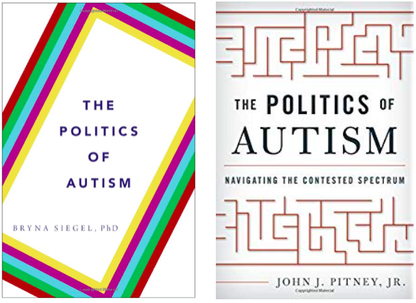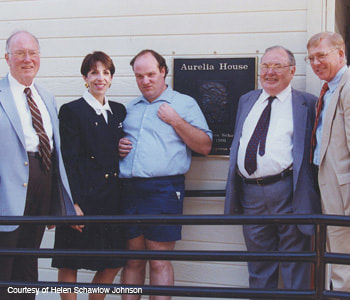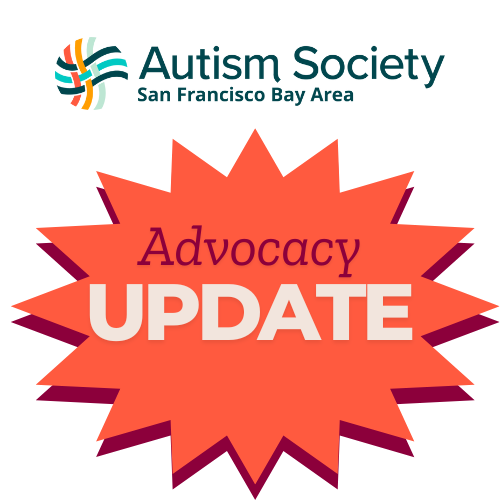Bryna Siegel Truth-Bombs Autism
Her opinionated “The Politics of Autism” offers timely lessons for the autism community, if you can overlook the flippant digressions

Not to be confused with Jack Pitney’s 2015 work by the same title, Siegel’s new book, left, would have been more aptly named something like “Reality Checking Autism: A Better Path Forward,” suggests our reviewer.BOOK REVIEW
By Jill Escher
Over the past three decades the mental disabilities collectively known as autism—once barely a blip on anyone’s radar—have risen to become a preeminent societal issue. The staggering increase in neurodevelopmental pathology has prompted an explosion in research, interventions, and services, all in the name of — fingers crossed — better understanding the mysterious conditions and improved outcomes in those affected.
Perhaps after so much frantic effort it’s time for a reflective break, a frank re-evaluation of dogmas and assumptions that have driven our patchwork of priorities. Enter Bryna Siegel, a developmental psychologist formerly based at UCSF, who takes a stab at that goal with her new book, “The Politics of Autism.”
With 40 years of experience in autism behind her, Siegel is justifiably frustrated on many fronts: by the research priorities that have resulted in little insight or meaningful benefit for individuals and families living with autism; by an education system based more on wishful thinking than functional realities; by costly early intervention programs that produce few results; by the lack of social policy directed at supporting intensive lifespan needs; by the sugar-coaters who portray autism as a gift; by the charlatans who ensnare vulnerable families; and more. Few areas are spared her critical eye.
Those truth bombs are important contributions to today’s heated discourse about autism, but before discussing them I fear I must detour to point out some serious problems in the book. Most notably, Siegel sinks into snideness and sloppiness in her treatment of the dramatic spike in prevalence. While she never comes out and explicitly denies the increase, indeed, she calls it “poorly understood,” Siegel wastes nearly an entire chapter on innuendo, speculation, and pure anecdotal dreck to try to paint of picture of an autism population that has been exploding due to… social factors. Without offering data to back up her flimsy claims, she essentially blames the stupendous numbers of young people diagnosed with autism today on a torrent of false positives.
This is, of course, preposterous. To illustrate, let’s do something she conspicuously fails to do, and look at data. In the San Francisco Bay Area, where both Siegel and I live and work, our state Department of Developmental Services (DDS) ascertained 650 autism cases in 1990. Today that number has soared to 13,501 Bay Area autism cases (Fig. 1), an increase of 20-fold in less than 30 years. Similarly, statewide DDS autism numbers have risen from about 4,000 to 107,000 over about 30 years, all in a system limited to developmental disability-type cases involving serious functional deficits. From a prevalence perspective, DDS autism soared from 1 case per 1,000 to about 11 cases per 1,000 between 1987 and 2010 (Fig. 2). Further, Siegel must be aware that several examinations of the DDS data have concluded diagnostic shift, broadening of criteria, and immigration could not account for the increased prevalence. And of course there is no evidence of a vast lost tribe of seriously developmentally disabled autistic adults undetected by our robust developmental services system.

(Please note that the 2011-13 drop-off in Figure 2 is likely due to delay in cases entering the DDS system, not a true decrease in prevalence.)Because our region and state have so clearly experienced an unprecedented deluge of seriously disabling autism cases, I nearly choked on my breakfast when Siegel recycled tired old tropes to explain the increase. She blames service-seeking “squeaky wheel” parents, clinicians who “diagnose for dollars,” and awareness campaigns making us “autism sensitized.” “Seek and ye shall find,” she quips, as if detecting heartbreaking, disabling derailed brain development was like an Easter egg hunt. She blames practitioners mistaking a screening instrument for a diagnostic workup, the educational definition of autism being broader than the DSM, access to the internet, the ABA industry desperately seeking subjects, Renee Russo’s cleavage (yup), and even Big Pharma.
Her flippant discussion of this devastating topic, so heartbreakingly devoid of alarm or data-based analysis, is an insult to the crisis-ridden autism community. The autism crush has ballooned into one of the greatest public health and social services crises of our time, yet reading this bizarre chapter, you would think our bursting-at-the-seams autism system was borne of nothing more than mass delusion.
Another weakness, somewhat related to the first, is Siegel’s tendency toward snarky condescension toward autism parents. She insinuates we exaggerate benign developmental delays as autism, cheat the system, and advocate to the point where we’re somehow causing artificial inflation of autism numbers. In one breath she says we do too much for our children, and in the next that we don’t do enough for them. (If our autistic 27 year-old hygiene-challenged son has no friends and no job perhaps it’s because we “infantilized” him or “waited too long” to access vocational training. Give me a break.)
The book also suffers from structural defects. It’s long winded and often painfully repetitive, so much so that it seems to have escaped the discerning gaze of an editor. Finally, let’s talk about the title. Considering that political science professor and political commentator Jack Pitney published a book under the same title in 2015, you would think she could spare a few minutes concocting something fresh. Hers could have been more appropriately called something like “Reality Checking Autism: A Better Path Forward,” or “Something Rotten in the State of Autism: Fixing our Broken System.”
Enough of that. Back to the t-bombs.
I appreciated Siegel’s mission to spotlight the “misguided priorities that have left behind the real needs of most individuals and families living with autism.” We absolutely need people in the trenches to question our unacceptable status quo and elevate the public dialogue about how we can serve urgent needs.
One area of focus is the very definition of “autism.” Siegel wisely suggests the DSM, the diagnostic manual used to diagnose mental disorders, over-lumps too many clinically diverse phenotypes under a single category of “autism spectrum disorder.” While her presentation of what clinical presentation she considers “autism” is difficult to discern, she invokes four rough groups as she discusses diagnosis, intervention and programs: Aspergers (intellectually capable but with executive function deficits and social disability); high functioning autism (which she notes is not actually high functioning at all, only in comparison to the more challenged groups); moderate autism (a pretty severe disorder but with intellectual disability and some capacity for communication and self-care); and low functioning autism (more severe intellectual disability and functional impairments). It would be useful to see subtypes like these reflected in the diagnostic manuals.
After diagnosis, what comes next? Siegel is on the mark when she likens the current clinical norm to “diagnose and adios.” Practitioners may draw blood to rule out rare conditions, or perform neuroimaging to spot a rare abnormality, but “[o]therwise, there is nothing further.” There is little in the way of follow-up care, even as clinicians side-step heart-wrenching questions about prognosis early in the process (remaining tight-lipped even when “any truth teller could see this child will never get to the point of functioning independently”). Instead of adios, she wants more truthiness from diagnosticians followed by a continuum of re-evaluations to help guide ongoing treatment and intervention. For example, by age 5 or 6 a clinician can revise treatment recommendations depending on whether a patient is responding robustly to intensive intervention or not. A reassessment at age 10 could determine if a child has a severe developmental disability, and if so, whether the child should more reasonably be assigned to a daily living skills track in school. These are common-sense recommendations, but insurance will need to pay and clinicians will need better tools to meaningfully guide treatment.
Most young children diagnosed with autism enter early intervention programs, typically based on applied behavior analysis, or ABA. Siegel is a proponent of early intervention, but only to a point. She sees it too often over-promises and under-delivers, particularly for those with intellectual disability, and can be a “costly charade” premised on faulty or exaggerated research. In the end, treatments can be more of a “palliative for the parents than [] an actual treatment for the child.” Harsh, but fair—despite hype and good intentions, autism has proven remarkably hard-wired and notoriously resistant to intervention. At a recent ABA convention I spoke on a panel about how ABA agencies should ideally not be ABA agencies at all, but instead be more like “Autism Family Support Agencies” offering a variety of cost-effective tools to support therapeutic, lifespan care and consultation needs for affected families over the course of a lifetime, seemingly quite a Siegelian idea.
Siegel also seeks an honest dialogue about special education, which she says can be wasteful while not supporting the best future for children with autism. For those who are moderately or severely autistic, she is particularly concerned with curriculum “aimed at learning the alphabet, spelling, basic writing, and doing rote math,” rather than skills of daily living. While I think she is over-stating the problem, as most classes tend to veer toward pragmatics and away from academics over time, she is not incorrect that we need more emphasis on preparation for daily life. She also critiques inclusion, for which she says there is virtually no evidence of furthering long-term goals in many cases. Regarding disputes over a child’s educational program she would like to see expert arbitration used in lieu of today’s stressful and costly adversarial process, an idea that seems worth further discussion.
With respect to building employability and long-term residential options for adults, Siegel decries the lack of services when students “falls off the services cliff” at age 18 or 22. Realistic job programs are few and far between, while our nation’s current answer to the autism housing crisis is to not offer an answer. We close institutions but de-fund alternative programs. So, as parents age and grow infirm, where will adult children with autism live? With understatement, Siegel says there is “nothing even near the number of options or the number of placements there need to be.” She correctly notes that capable siblings, should there be any, tend not to willingly accept such overwhelming responsibility. She clearly would like to see the proliferation of an abundance of options, including supported communities coordinated with work or day programs. She astutely says the current vogue for calling live-work communities “institutions” is a “ridiculous position.” Indeed her common-sense thinking on this subject is one of the highlights of the book. The book touches on the need for new sources of funding and tax breaks to unleash a variety of new projects, but unfortunately does not elaborate.
A considerable amount of ink is devoted to decrying the autism world’s omnipresent nonsense — drugs, diets, supplements, auditory and sensory integration training, and other schemes for which there is little or no empirical evidence of efficacy. With respect to the myth-that-will-not-die vaccine hypothesis, Siegel covers territory recently trod by other books such as In a Different Key by John Donvan and Caren Zucker, and I’m not sure contributes anything new.
The sugar-coated vocabulary adopted by some advocates is the target of some of her best truth bombs. Neurodiversity, for example, is a term that “obfuscates the real difficulties with which people with some strengths and some inherent, autistic weaknesses struggle.” She says the concept “can only be described as classical Orwellian doublespeak, that being handicapped by whatever handicaps them as an Aspie is actually not a handicap but a beneficial endowment.”
Her final target is the bulk of autism research, primarily genetics and neuroscience, which she says bluntly “is unlikely to help any child with autism alive today.” This research, while important to a degree, has yielded “very little of clinical significance or that is actionable,” which is too tragically true. She laments the essential futility of her work: “I have spent my career doing what is essentially palliative care…. I am pretty sure what I do will never come to the point of significantly alleviating most signs of autism in most individuals that have them.” She wants to see research priorities that better benefit autistic people, their families and their caregivers. She’s hardly the first person to say this, but nevertheless amen to that.
It’s time for a change in how we address autism. Though Siegel’s book misfires in places, it offers many pragmatic recommendations that should be taken seriously, particularly with respect to school-age children. For adults, she passively observes the obvious crisis without offering viable recommendations, but at least her acknowledgment is a start.
Jill Escher is president of Autism Society San Francisco Bay Area.
Disclaimer: The opinions and assertions stated in the SFASA blog are those of the individual authors, may not reflect the opinions or beliefs of SFASA, and do not reflect the opinions of the Autism Society of America. SFASA is an independent affiliate of the Autism Society of America, the leading grassroots autism organization.







